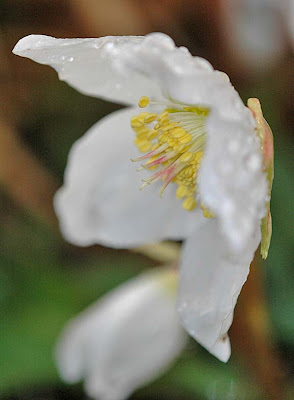By November the first frosts have arrived and the nights have drawn in. Low winter sunlight highlights the papery seed cases of the honesty plants, whose flowers attracted butterflies and bees back in the early summer.
I allow all the old withered seed heads to remain throughout the winter, providing food for birds. I'd much rather have a wildlife-friendly garden than a tidy one. In hard winters I've seen blue tits peck holes in poppy capsules like this, to reach the small insects that spend the winter inside.
Autumn's crop of berries disappeared fast - except for the yellow-berried holly. The birds took all the red holly berries long before Christmas but the yellow counterparts would still be there, untouched, in spring.
The first snow-fall in December came as a surprise after a long, mellow autumn and we didn't expect the snow to linger for long. It was to last until mid-January.
Constant heavy snow hid the debris of last year's garden, half-buried the greenhouse and weighed down branches............
... so indoor gardening became the only option. Tibouchina plants, grown from cuttings taken last spring, flowered right through the darkest days of winter in the conservatory.
At Christmas the skeletonised remains of the fruits of the Chinese lantern plants (Physalis) growing outside the conservatory provided decorations for the Christmas tree - with a touch of gold lacquer.
Even when snow covered the ground a few plants still flowered outside, including the winter sweet bush (Chimonanthus), whose flowers produce a perfume even in the coldest weather.
The heavy snow brought more birds and animals into the garden than ever before. We had visits from grey squirrels on a few occasions in the past, but now they became regulars on the bird table. Cute and entertaining ........... but will they become a nuisance next year?
Bramblings have been rare visitors in the past but this year a flock of about twenty became regular customers at the bird table from Christmas onwards - and were particularly fond of black sunflower seeds.
A family of five bullfinches visited the crab apple tree every day for about a month, shredding the rotting fruits to reach the seeds inside, but the most memorable bird visitors by far were....
.... this flock of waxwings. For just half an hour, on a grey dawn in January, this noisy flock of about twenty raided the frost-softened crab apples. It was a magical moment - and watching them made me late for work. You can trace their visit back to that bumper display of crab apple blossom in spring, that produced such a heavy crop of fruit.
The snow may have gone but hard frosts still turned the soil to iron. Norway maple seeds that had blown in during last autumn's gales lay on the soil surface, waiting to germinate as soon as the weather became milder. Left to its own devices, the garden would become woodland within a few years.
Bitterly cold weather in early February created a frost garden. The downy leaves of mulleins were covered in frost at dawn ,which melted into sparkling water droplets as the sun rose.
Frost crystals etched the surface of bramble leaves in the hedge ....
.... decorated the edges of ivy foliage .....
... and grew into a forest of crystals, so that ....
.... even weeds like stinging nettles acquired an icy beauty.
Undeterred by the cold, the lenten roses pushed through the soil whenever a thaw set in ....
... and the sweet scent of this winter-flowering honeysuckle Lonicera x purpusii hung in the air.
The first snowdrop leaf tips usually begin to push through the soil in January but the icy winter slowed them down and it was late February before they were at the best, threading themselves through last autumn's dead flower stems - that I never got around to removing. A new gardening cycle had begun, rising through the decaying remains of the last ............ and now it was time to get ready for the coming year.
I wished I had dug the vegetable plot before the cold weather set in, then the frost would have broken the soil down into a fine tilth, the weeds would have been deterred and it wouldn't have been such hard work to get this soil back into good condition.
Still, during all those days of inactivity, when I could do nothing but stare out of the window at a snow-covered garden and regret the passing of yet another gardening year, I had time to hatch plans for the coming campaign. Ambition set in again. I have plans for this corner, but first I'll need to remove this conifer stump, whose roots have turned out to be unexpectedly large and wide-ranging. This is going to be hard work....
So here we are on the threshold of another gardening year, with much to do and spring already loosening the bud scales of some of the shrubs, like this Amelanchier. Given good fortune, each of us will only experience spring's sense of expectation and reawakening around seventy or eighty times in a lifetime. Every year, at this time, I make a resolution not to miss a moment of the next one that's on the way. Time to pull on the wellies and gardening gloves once again.


























I shall miss this programme, which I thoroughly enjoyed. At least your blog will allow me access to the written word. Thank you Phil.
ReplyDeleteThanks Toffeeapple - I'm not quite sure what to do with the blog now that the programmes have finished - maybe continue it in a separate linked blog on a monthly basis. Meanwhile, some seeds of hankerchief tree (aka ghost tree aka dove tree aka Davidia involucrata) that I collected and sowed two years ago have just germinated!
ReplyDeleteOoh, I can imagine your excitement at the germination. At least leave this blog up for a while longer, please.
ReplyDelete